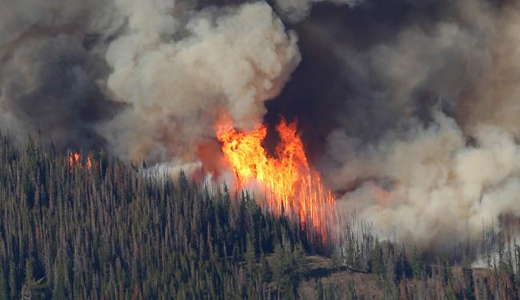
Wildfires have been blazing on all summer, and the latest of them is occurring in Oregon, near the Columbia River Gorge. Owners of 140 homes have already evacuated, and despite the efforts of 400 firefighters, the flames have continued to spread over five square miles. Meanwhile in northern Idaho, another brushfire has burned across 64 square miles and destroyed five structures. But efforts to combat the blazes may be fruitless, because the money to fight them is running out.
Tom Vilsack, U.S. Secretary of Agriculture, said Aug. 5 that the U.S. Forest Service’s annual budget for fighting wildfires is rapidly dwindling; in fact, it may run out by the end of the month. The fires, on the other hand, will keep burning. He suggested they were in the midst of a catch-22, as when the Forest Service’s funding runs dry, it will need to dip into other projects designed to help prevent future wildfires, in order to put out the ones currently blazing. Specifically, about $400-500 million will be taken away from such projects, putting the future in jeopardy in terms of further disasters.
Vilsack, who is lobbying for an extra $615 million for the Forest Service to fight wildfires this year and next, remarked, “When we begin to run out of money, we have to dip into the very programs that will reduce the risk of these wildfires over [a longer period of] time.” And those accounts aren’t the only ones that suffer; in the past, they have also had to draw from other programs not related to wildfires. Such a transfer occurred in 2012, when the funding for road repairs in Arkansas’ Ouachita National Forest was instead used to contend with fires throughout the U.S.
The fire in Idaho, called the Big Cougar Fire, is only 15 percent contained, and 200 more structures in its path risk becoming damaged or destroyed unless firefighters can contain it further. Resources are being used while there’s still funding for them, and include four helicopters, four fire engines, and three dozers. Isolated thunderstorms are expected, but those are unpredictable; rain could help quell the flames, but lightning could spark an entirely new blaze.
One of the reasons the Forest Service and the Department of Agriculture are so hot and bothered over the depletion of yearly wildfire money is due to the likelihood that there will be many more fires. In the past, a depletion of funding by the end of August might have been manageable, but global warming has changed that. Wildfires are now likely to occur much later in the year than August.
“The really amazing thing is that we don’t just see an increase in one or two regions,” said Philip Dennison, a geographer at the University of Utah in Salt Lake City. “We’re seeing it almost everywhere – in the mountain regions, in the Southwest… That tells us that something bigger is going on, and that thing appears to be climate change.”
This increases the risk for firefighters as well – even more reason why sufficient funding is necessary. Robert Bonnie, undersecretary for natural resources with the Department of Agriculture, explained, “Fire behavior is more extreme now. We’re seeing larger fires. We’re seeing fires where we have more houses and people. That makes them more dangerous and more difficult to fight.”
The money isn’t there because the Republican controlled Congress isn’t doing anything to put it there, according to a report by U.S. News. A bill to overhaul the way wildfire fighting is funded was introduced by Rep. Mike Simpson, R-Idaho – and then promptly abandoned by him. Simpson gave no explanation why.
Vicki Minor, executive director of the Wildland Firefighter Foundation, a nonprofit group that helps families of firefighters killed in the line of duty, said, “Because of these fires, we lose our watersheds, we lose our hunting ranges, we lose our homes. These fire seasons are not going away, and for them to not fund wildfires… I’m just disgusted with them.”
Photo: The Oregon wildfire continues to burn. AP










